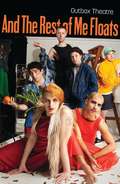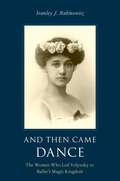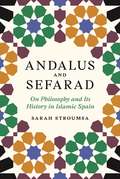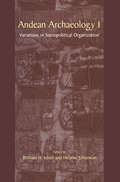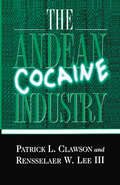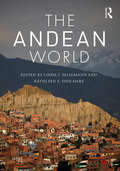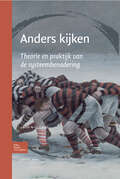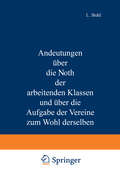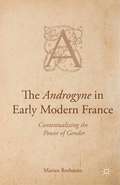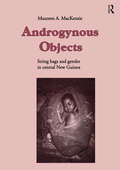- Table View
- List View
And the Mirror Cracked: Feminist Cinema and Film Theory
by A. SmelikAnd The Mirror Cracked explores the politics and pleasures of contemporary feminist cinema. Tracing the highly productive ways in which feminist directors create alternative film forms, Anneke Smelik highlights cinematic issues which are central to feminist films: authorship, point of view, metaphor, montage and the excessive image. In a continuous mirror game between theory and cinema, this study explains how these cinematic techniques are used to represent female subjectivity positively and affirmatively. Among the films considered are A Question of Silence , Bagdad Cafe , Sweetie and The Virgin Machine .
And the Rest of Me Floats (Oberon Modern Plays)
by Outbox TheatreI was born in 1994, then came Windows 95, And I would dive online to be the true me – A 2cm avatar with a denim mini and a high pony. Online all the time, to avoid conversation and the frustration of being a he, she, they or me… I felt free. And The Rest Of Me Floats is all about the messy business of gender. Performers from across the trans, non-binary, and queer communities weave together autobiographical performance, movement, pop songs, stand-up and dress-up in this anarchic celebration of gender expression and identity. Playful and powerful, And The Rest Of Me Floats explores how it feels to live in a society where you are regularly categorised and policed. ‘Do you see me?’ Beyond the questions, the confusion, and the anger – ‘Do you really see me?’
And Then Came Dance: The Women Who Led Volynsky to Ballet's Magic Kingdom
Presenting for the first time Akim Volynsky's (1861-1926) pre-balletic writings on Leonardo da Vinci, Fyodor Dostoevsky, Otto Weininger, and on such illustrious personalities as Zinaida Gippius, Ida Rubinstein, and Lou Andreas-Salome, And Then Came Dance provides new insight into the origins of Volynsky's life-altering journey to become Russia's foremost ballet critic. A man for whom the realm of art was largely female in form and whose all-encompassing image of woman constituted the crux of his aesthetic contemplation that crossed over into the personal and libidinal, Volynsky looks ahead to another Petersburg-bred high priest of classical dance, George Balanchine. With an undeniable proclivity toward ballet's female component, Volynsky's dance writings, illuminated by examples of his earlier gendered criticism, invite speculation on how truly ground-breaking and forward-looking this critic is.
AND THEN CAME DANCE C: The Women Who Led Volynsky to Ballet's Magic Kingdom
by Stanley J. RabinowitzPresenting for the first time Akim Volynsky's (1861-1926) pre-balletic writings on Leonardo da Vinci, Fyodor Dostoevsky, Otto Weininger, and on such illustrious personalities as Zinaida Gippius, Ida Rubinstein, and Lou Andreas-Salome, And Then Came Dance provides new insight into the origins of Volynsky's life-altering journey to become Russia's foremost ballet critic. A man for whom the realm of art was largely female in form and whose all-encompassing image of woman constituted the crux of his aesthetic contemplation that crossed over into the personal and libidinal, Volynsky looks ahead to another Petersburg-bred high priest of classical dance, George Balanchine. With an undeniable proclivity toward ballet's female component, Volynsky's dance writings, illuminated by examples of his earlier gendered criticism, invite speculation on how truly ground-breaking and forward-looking this critic is.
And Then We Work for God: Rural Sunni Islam in Western Turkey
by Kimberly HartTurkey's contemporary struggles with Islam are often interpreted as a conflict between religion and secularism played out most obviously in the split between rural and urban populations. The reality, of course, is more complicated than the assumptions. Exploring religious expression in two villages, this book considers rural spiritual practices and describes a living, evolving Sunni Islam, influenced and transformed by local and national sources of religious orthodoxy. Drawing on a decade of research, Kimberly Hart shows how religion is not an abstract set of principles, but a complex set of practices. Sunni Islam structures individual lives through rituals—birth, circumcision, marriage, military service, death—and the expression of these traditions varies between villages. Hart delves into the question of why some choose to keep alive the past, while others want to face a future unburdened by local cultural practices. Her answer speaks to global transformations in Islam, to the push and pull between those who maintain a link to the past, even when these practices challenge orthodoxy, and those who want a purified global religion.
Andalus and Sefarad: On Philosophy and Its History in Islamic Spain (Jews, Christians, and Muslims from the Ancient to the Modern World #62)
by Sarah StroumsaAn integrative approach to Jewish and Muslim philosophy in al-AndalusAl-Andalus, the Iberian territory ruled by Islam from the eighth to the fifteenth centuries, was home to a flourishing philosophical culture among Muslims and the Jews who lived in their midst. Andalusians spoke proudly of the region's excellence, and indeed it engendered celebrated thinkers such as Maimonides and Averroes. Sarah Stroumsa offers an integrative new approach to Jewish and Muslim philosophy in al-Andalus, where the cultural commonality of the Islamicate world allowed scholars from diverse religious backgrounds to engage in the same philosophical pursuits.Stroumsa traces the development of philosophy in Muslim Iberia from its introduction to the region to the diverse forms it took over time, from Aristotelianism and Neoplatonism to rational theology and mystical philosophy. She sheds light on the way the politics of the day, including the struggles with the Christians to the north of the peninsula and the Fāṭimids in North Africa, influenced philosophy in al-Andalus yet affected its development among the two religious communities in different ways.While acknowledging the dissimilar social status of Muslims and members of the religious minorities, Andalus and Sefarad highlights the common ground that united philosophers, providing new perspective on the development of philosophy in Islamic Spain.
Andalus and Sefarad: On Philosophy and Its History in Islamic Spain (Jews, Christians, and Muslims from the Ancient to the Modern World #62)
by Sarah StroumsaAn integrative approach to Jewish and Muslim philosophy in al-AndalusAl-Andalus, the Iberian territory ruled by Islam from the eighth to the fifteenth centuries, was home to a flourishing philosophical culture among Muslims and the Jews who lived in their midst. Andalusians spoke proudly of the region's excellence, and indeed it engendered celebrated thinkers such as Maimonides and Averroes. Sarah Stroumsa offers an integrative new approach to Jewish and Muslim philosophy in al-Andalus, where the cultural commonality of the Islamicate world allowed scholars from diverse religious backgrounds to engage in the same philosophical pursuits.Stroumsa traces the development of philosophy in Muslim Iberia from its introduction to the region to the diverse forms it took over time, from Aristotelianism and Neoplatonism to rational theology and mystical philosophy. She sheds light on the way the politics of the day, including the struggles with the Christians to the north of the peninsula and the Fāṭimids in North Africa, influenced philosophy in al-Andalus yet affected its development among the two religious communities in different ways.While acknowledging the dissimilar social status of Muslims and members of the religious minorities, Andalus and Sefarad highlights the common ground that united philosophers, providing new perspective on the development of philosophy in Islamic Spain.
Andean Archaeology I: Variations in Sociopolitical Organization
by William H. Isbell Helaine SilvermanStudy of the origin and development of civilization is of unequaled importance for understanding the cultural processes that create human societies. Is cultural evolution directional and regular across human societies and history, or is it opportunistic and capricious? Do apparent regularities come from the way inves tigators construct and manage knowledge, or are they the result of real constraints on and variations in the actual processes? Can such questions even be answered? We believe so, but not easily. By comparing evolutionary sequences from different world civilizations scholars can judge degrees of similarity and difference and then attempt explanation. Of course, we must be careful to assess the influence that societies of the ancient world had on one another (the issue of pristine versus non-pristine cultural devel opment: see discussion in Fried 1967; Price 1978). The Central Andes were the locus of the only societies to achieve pristine civilization in the southern hemi sphere and only in the Central Andes did non-literate (non-written language) civ ilization develop. It seems clear that Central Andean civilization was independent on any graph of archaic culture change. Scholars have often expressed appreciation of the research opportunities offered by the Central Andes as a testing ground for the study of cultural evolu tion (see, e. g. , Carneiro 1970; Ford and Willey 1949: 5; Kosok 1965: 1-14; Lanning 1967: 2-5).
Andean Archaeology II: Art, Landscape, and Society
by Helaine Silverman William H. IsbellThe origins and development of civilization are vital components to the understanding of the cultural processes that create human societies. Comparing and contrasting the evolutionary sequences from different civilizations is one approach to discovering their unique development. One area for comparison is in the Central Andes where several societies remained in isolation without a written language. As a direct result, the only resource to understand these societies is their material artifacts.In this second volume, the focus is on the art and landscape remains and what they uncover about societies of the Central Andes region. The ancient art and landscape, revealing the range and richness of the societies of the area significantly shaped the development of Andean archaeology. This work includes discussions on: - pottery and textiles; - iconography and symbols; - ideology; - geoglyphs and rock art.This volume will be of interest to Andean archaeologists, cultural and historical anthropologists, material archaeologists and Latin American historians.
Andean Archaeology III: North and South
by Helaine Silverman William IsbellThe third volume in the Andean Archaeology series, this book focuses on the marked cultural differences between the northern and southern regions of the Central Andes, and considers the conditions under which these differences evolved, grew pronounced, and diminished. This book continues the dynamic, current problem-oriented approach to the field of Andean Archaeology that began with Andean Archaeology I and Andean Archaeology II. Combines up-to-date research, diverse theoretical platforms, and far-reaching interpretations to draw provocative and thoughtful conclusions.
The Andean Cocaine Industry
by P. Clawson R. LeeIt is commonly known that the Andean nations of Colombia, Peru, and Bolivia are the international centers of cocaine production. But until now, there has been no comprehensive view of this billion dollar industry. Using never-before unearthed information culled from their extensive field research, Patrick Clawson and Rensselaer Lee reveal the configuration of the drug industry, from the original cultivation of coca in the fields of South America to the sale of cocaine on the streets of the United States. The authors analyze the economic and political impact of the drug business on the Andean nations, including such problems as violence and the undermining of legitimate business. Through the ground-breaking work of Clawson and Lee, The Andean Cocaine Industry illuminates one of the most pervasive problems facing the world today.
Andean Foodways: Pre-Columbian, Colonial, and Contemporary Food and Culture (The Latin American Studies Book Series)
by John E. StallerThere is widespread acknowledgement among anthropologists, archaeologists, ethnobotanists, as well as researchers in related disciplines that specific foods and cuisines are linked very strongly to the formation and maintenance of cultural identity and ethnicity. Strong associations of foodways with culture are particularly characteristic of South American Andean cultures. Food and drink convey complex social and cultural meanings that can provide insights into regional interactions, social complexity, cultural hybridization, and ethnogenesis. This edited volume presents novel and creative anthropological, archaeological, historical, and iconographic research on Andean food and culture from diverse temporal periods and spatial settings. The breadth and scope of the contributions provides original insights into a diversity of topics, such as the role of food in Andean political economies, the transformation of foodways and cuisines through time, and ancient iconographic representations of plants and animals that were used as food. Thus, this volume is distinguished from most of the published literature in that specific foods, cuisines, and culinary practices are the primary subject matter through which aspects of Andean culture are interpreted.
The Andean World (Routledge Worlds)
by Linda J. Seligmann Kathleen S. Fine-DareThis comprehensive reference offers an authoritative overview of Andean lifeways. It provides valuable historical context, and demonstrates the relevance of learning about the Andes in light of contemporary events and debates. The volume covers the ecology and pre-Columbian history of the region, and addresses key themes such as cosmology, aesthetics, gender and household relations, modes of economic production, exchange, and consumption, postcolonial legacies, identities, political organization and movements, and transnational interconnections. With over 40 essays by expert contributors that highlight the breadth and depth of Andean worlds, this is an essential resource for students and scholars alike.
The Andean World (Routledge Worlds)
by Linda J. Seligmann Kathleen S. Fine-DareThis comprehensive reference offers an authoritative overview of Andean lifeways. It provides valuable historical context, and demonstrates the relevance of learning about the Andes in light of contemporary events and debates. The volume covers the ecology and pre-Columbian history of the region, and addresses key themes such as cosmology, aesthetics, gender and household relations, modes of economic production, exchange, and consumption, postcolonial legacies, identities, political organization and movements, and transnational interconnections. With over 40 essays by expert contributors that highlight the breadth and depth of Andean worlds, this is an essential resource for students and scholars alike.
Andere Sichtweisen auf Intersektionalität: Revisualising Intersectionality
by Elahe Haschemi Yekani Magdalena Nowicka Tiara RoxanneDas Buch hinterfragt die vermeintliche visuelle Evidenz von Kategorien menschlicher Ähnlichkeit und Differenz. Es bezieht Erkenntnisse aus den Sozial- und Kognitionswissenschaften sowie der Psychologie und Philosophie ein, um zu erklären, wie wir physische Unterschiede visuell wahrnehmen und zeigt, dass Wahrnehmung sowohl fehlbar als auch prozesshaft ist. Dazu bringen die Autorinnen Studien zur visuellen Kultur und künstlerische Forschung mit Ansätzen wie Gender, Queer und Trans Studies sowie postkolonialer Theorie miteinander ins Gespräch, um vereinfachte Vorstellungen von Identitätspolitik und kultureller Repräsentation zu verkomplizieren. Das Buch schlägt andere Sichtweisen auf Intersektionalität vor, um die Vorherrschaft von Kategorien der vermeintlich sichtbaren Differenz wie race und Geschlecht als analytische Kategorien infrage zu stellen.
Anders als normal: Illegale Drogen als Medium der biographischen Entwicklung junger Frauen (Münchner Studien zur Kultur- und Sozialpsychologie)
by Alexandra HolzerIm Unterschied zur klinisch-individualpsychologischen Sichtweise ist diese sozialpsychologische Untersuchung nicht an einer weiteren defizitären Zuschreibungspraxis an die befragten acht jungen Frauen mit einem mehr oder weniger riskanten Drogenkonsum interessiert. Statt dessen folgt sie mit einem sensiblen Personenbezug den persönlichen Beweggründen für die einzelnen, zum Teil sehr unterschiedlichen (drogenbezogenen) Handlungs- und Lebensformen. Die narrativen, biographisch-orientierten Interviews sollen den interessierten Leser/innen die anderen Wirklichkeiten konkret handelnder Personen eröffnen, die weit über die gängigen Klischees vom abgestürzten Junkie hinausführen: Drogen-Handlungen und Sucht-Entwicklungen werden hier grundsätzlich als ein vielschichtiges, prozeßhaftes Geschehen rekonstruiert, dessen Dynamik erst angemessen verstanden werden kann, wenn die individuellen Seins- und Handlungsweisen mit den jeweiligen Gesellschafts- und Lebensbedingungen in Beziehung gesetzt werden. In diesem Sinne sollte auf (drogen)politischer Ebene weniger in stigmatisierende Kontroll- und Strafmaßnahmen als vielmehr in eine differenzierte, Zielgruppenorientierte Suchtforschung und -therapie investiert werden.
Anders kijken: Een breder zicht op menselijk gedrag. theorie en praktijk van de systeembenadering
by J. WillemseDoor de jaren heen is veel methodiek ontwikkeld op het terrein van hulpverlening aan gezinnen. Met betrekking tot het werken met leefgroepen, teams en wijken en ten aanzien van het kijken naar organisaties is de systematische methodiekontwikkeling minder verder voortgeschreden. Dit boek is voor de toepassing van die systeembenadering een stimulans. In het boek worden theorie en praktijk op een geïntegreerde en samenhangende wijze gepresenteerd. Het legt voortdurend verbindingen met de beroepspraktijk. Deel I en II gaat over de theorie. Hier wordt de lezer grondig geïnformeerd over het begrip systeem, over interactie en communicatie, over de centrale begrippen inhoud en betrekking, over het onderscheid tussen analoge en digitale communicatie, over complementaire en symmetrische interactie, over lineaire en circulaire causaliteit en paradoxale communicatie. Deel III is gewijd aan de toepassingsterreinen, waarop de theorie betrekking heeft: gezinnen, leefgroepen, organisaties en wijken.De didactische kracht van het boek zit vooral in de voorbeelden. Wie moeite heeft met de begripsmatige en theoretische uiteenzettingen, kan door het lezen van de voorbeelden genieten van een grote reeks soms tragikomische miniverhalen die de theorie verduidelijken en tot leven brengen. De voorbeelden hebben tevens als functie de lezer te prikkelen om met eigen verhalen te komen. Uitermate geschikt voor de opleiding voor sociaal-pedagogisch en sociaal-juridisch hulp- en dienstverleners, maatschappelijk werkers, pedagogen en artsen.
Andeutungen über die Noth der arbeitenden Klassen und über die Aufgabe der Vereine zum Wohl derselben
by L. BuhlAndré Malraux: A Reassessment
by G. HarrisThis book analyses Malraux's writing from his journalism in Indochina to his novels, art studies and (anti)memorialist essays. Cutting through the established dual biographical image of Malraux as a committed leftwinger and revolutionary novelist turned unconditional Gaullist and diehard anti-Communist at the Liberation, it makes a balanced assessment of Malraux as a non-ideological if elitist artist who shaped his public role as much as he shaped the existence of his heroes both novelistic and real.
Andrej Sacharow: Ein Leben für Wissenschaft und Freiheit
by Gennady GorelikWie wurde aus dem Physiker Andrej Sacharow ein Vorkämpfer für die Menschenrechte? Darauf gibt diese Biografie eine Antwort, indem sie dem Physiker und der öffentlichen Person gleichermaßen gerecht wird. Gestützt auf bisher unzugängliche Dokumente und Augenzeugenberichte, zeigt der Autor zum einen, dass Spionage zwar den Anstoß zum sowjetischen Kernwaffenprojekt gab, die Wasserstoffbombe jedoch unabhängig davon erfunden wurde. Zum anderen erhellt er Sacharows Beweggründe, 1968 mit seinen regimekritischen Gedanken an die Öffentlichkeit zu treten.
Andrew Carnegie: Little Boss
by Dr James MackayAndrew Carnegie (1835–1922) was a mass of contradictions: a radical Chartist who became a rabid capitalist, an idealist who was also a profound cynic, a committed pacifist who also played a crucial role in the opening part of the American Civil War, and a ladies’ man who had to wait until his fifties (after his domineering mother died) before forming a meaningful relationship with a woman. From bobbin boy in a Pittsburgh factory he progressed to messenger boy, telegraphist and railway superintendent. His meteoric rise owed much to his boss, Thomas Scott, who also cut the young Carnegie in on his first lucrative share deal. The youth who earned thirty-five dollars a month was on the road to his first million within a year or two, and he never looked back. Speculation in rolling-stock and railways, the nascent oil industry, iron and, above all, steel made Carnegie the richest man in the world. Along the way he created fortunes for many others, but trampled on friend and foe alike in his relentless pursuit of money. Then, the man who amassed the largest fortune in the world proceeded to give most of it away. From free libraries to world peace, the Carnegie millions were pumped into a host of worthy causes. The Peace Palace at the Hague is the lasting legacy of this global philanthropy; but Carnegie’s faith in the Kaiser to achieve world peace was shattered by the outbreak of the First World War, and it was a setback from which he never recovered. This candid and penetrating biography follows Carnegie from his humble birthplace in Dunfermline to the squalor of Allegheny City and Pittsburgh in the 1840s, and charts his dramatic rise to fame and fortune. Set against the contrasting backdrops of radical Scotland and America during the most turbulent phase of its development, Little Boss is the definitive story of one of the world’s greatest captains of industry.
The Androgyne in Early Modern France: Contextualizing the Power of Gender
by Marian RothsteinBased on sources in Genesis and Plato's Symposium , the androygyne during Early Modern France was a means of expressing the full potential of humans made in the image of God. This book documents and comments on the range of references to the androgyne in the writings of poets, philosophers, courtiers, and women in positions of political power.
Androgynous Objects: String Bags and Gender in Central New Guinea (Studies in Anthropology and History)
by Maureen A. MacKenzieAndrogynous Objects explores the way meaning is encoded in material culture by focusing on the androgynous symbolism of the looped string bag, or bilum, of the Telefol people of Central New Guinea. The web of meanings 'woven' into the bag is shown to extend beyond women's lives and bodies. It is open to manipulation and reformation in a variety of contexts and is used by both Telefol women and men to explore, and so explain the complexities and ambiguities inherent in their social life.
Androgynous Objects: String Bags and Gender in Central New Guinea (Studies in Anthropology and History #Vol. 2)
by Maureen A. MacKenzieAndrogynous Objects explores the way meaning is encoded in material culture by focusing on the androgynous symbolism of the looped string bag, or bilum, of the Telefol people of Central New Guinea. The web of meanings 'woven' into the bag is shown to extend beyond women's lives and bodies. It is open to manipulation and reformation in a variety of contexts and is used by both Telefol women and men to explore, and so explain the complexities and ambiguities inherent in their social life.

